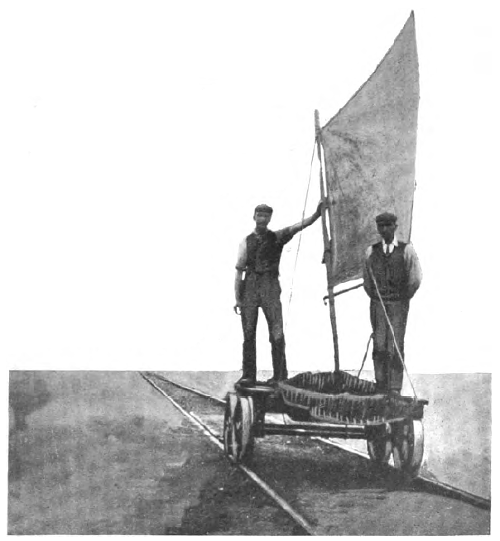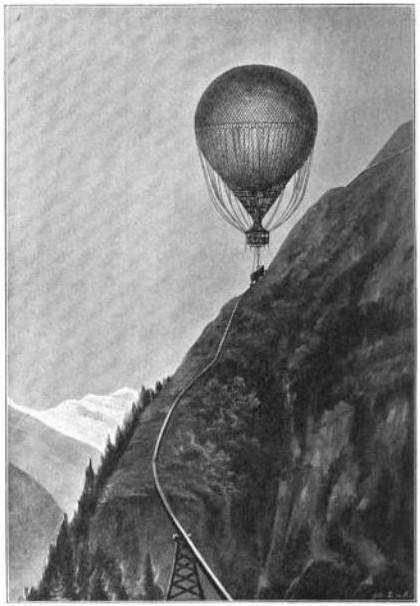
Two more railway oddities. When the local railroad closed its branch, the port of Thames Haven, in southeastern England, devised a trolley driven by the wind. “With a good breeze a speed of from twenty to twenty-five miles an hour can be attained with perfect safety,” reported The Railway Magazine in September 1905. “As can be seen by the photograph, the trolley is an ordinary one, such as are in common use by plate-layers on the railway.”
The second idea is even more dramatic — from Railway World, June 1, 1906:
Despatches from Geneva state that an Austrian engineer, Herr Balderauer, of Salzburg, has been experimenting with much success in the mountains near Salzburg with a novel balloon railway. It consists of a large captive balloon attached to a single steel rail, which in turn is fixed firmly to the side of a steep mountain, whose precipitous slopes no other form of railway could climb without making a series of serpentine detours and passing through tunnels. The balloon remains balanced in the air about ten yards above the rail to which it is attached by a stout wire cable, and it is moved up and down the side of the mountain at the will of the engineer. For an ascent the balloon itself furnishes the lifting force by means of hydrogen; for the descent a large reservoir attached to the balloon is filled with water at the highest station, and serves as ‘ballast.’ Under the balloon is a circular car, seating ten persons. The wire cable from the balloon passes through the floor of the car to a speed regulator underneath, which is controlled by the engineer.
I gather this was actually built, but I haven’t been able to find an image. I’ll keep looking.
12/29/2015 UPDATE: Evidently the balloon system was devised by Salzburg engineers named Balderauer and Brockebusch, who called it the Gebirgsbahn. A reader found this image in Illustrirte Zeitung, Sept. 30, 1897:

A “strong rope” connected the balloon to the running gear through a large opening in the “wreath-shaped” passenger car. The water reservoir, which could be filled to different heights according to the expected wind strength, was attached to the running gear, with a mechanism for the operator to release water as needed. The railway had a planned capacity of 1500 kg for passengers and aeronauts, and was to include a hangar for storing the balloon during windstorms, during which the operators planned to suspend service.
The inventors took a “small-scale proof-of-concept trip” in 1896, which they deemed “quite satisfactory,” and construction was scheduled for the following spring. In August 1901 New Zealand’s Feilding Star reported that “Not a single accident has occurred during three months of experiments, and the system is without any danger,” but we don’t find any mention of it after that.
(Thanks, Derek and Stephan.)
